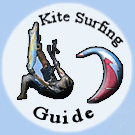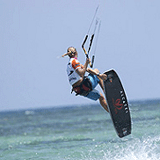Kites
When kitesurfing, any type of traction kite can be just as good. Remember that a traction kite is in fact a large controllable kite that, when flying, can easily generate pull. Nevertheless, there are some things that can make a kitesurfer choose one or the other type of kite, depending on his training and on the things he expects from his kite:
- Relauncheability: after a fall, the kitesurfer must be able to relaunch his kite from the water.
- High Performance: it is advised to own a kite of high performanca, as kitesurfers will want to easily jump and sail upwind.
- Power control: the power of the kite must be dinamically controllable on the water. A wider wind range for the kite is a guarantee of the ability to control the power of a kite.
The stores specialized in kitesurfing offer a great variety of kites, each of them being more or less relaunchable from the water. Kitesurfing kites can be divided in three major types:
- Inflatable kites
- Framed single skin kites
- Ram air foil kites
Inflatable Kites
The kites having inflatable leading edge and 5 or more inflatable battens are called inflatable kites. They have a "crescent moon" shape, and they can also be called an inflatable or Leading Edge Inflatable or LEI. Inflatable kites are quite dependable when relaunching in most conditions. The exceptions consist of under 6 - 7 knots light wind and an inverted bridle. The 2 lines LEI is even more harder to relaunch. Inflatable kites were invented by the original founders of Wipika, who have licensed it to many other producers. The patent dates back in 1984, so it must have expired by now. These manufacturers have continued the development of kites and have put their own version of kites on the markets. The kites generally have a an "intrusive" shape, so that relaunching from the water can be easier. That is the reason why the kites are always "powered up" even on the water. Having a working safety release system is the only chance of kitesurfing with this type of kite.
The 2 line and 4 line inflatables are the most common types of inflatable kites, each having an advantage over the other. 2 line inflatable kites are easier to use and have more stability, while 4 line inflatable kites are the ones to offer higher performance ability and better power control. The 4 line kites give the kitesurfer the possibility to change the Angle Of Attack or AOA of the kite and currently represent the majority of the surfing kites used nowadays.
Lately, inflatable kites have somehow led the kitesurfing markets, as they have several good characteristics, excellent wind range, ease of jump and wide range of choices. Together with the introduction of the 5th line to facilitate relaunching on snow, inflatable kites have gone big even in the kitesnowboarding and in the kiteskiing markets.
Framed Single Skin Kites
Kites having a leading edge made of fiber glass or graphite, one main batten in the center and a number of thin battens along the chord, in order to to give the kites the permanent shape, are called framed single skin kites. Just like when windsurfing , it is not easy to water launch a 2 line framed single skin kite, even with the help of a 2 line reel bar. It takes a lot of training before you learn how to do that. But as soon as you learn it, you will most likely say that the 2 line framed single skin kite are the best kites for water relaunching. The one exception to this is the fact that you won't be able to relaunch them, should the wind be under 8 – 10 knots. The 2 line framed single skin kite system was invented by KiteSki, which had Banshee make their kites. Along the years, Banshee and KiteSki developed and put on the market two different versions of the kites. A kitesurfer using a framed single skin kite will not need a safety release system anymore, as these kites stay flat on the water after a fall. Nevertheless, because the kite and the control bar may fly a fairly long distance down wind before landing on the water, it may be a good idea to have a safety release system to easily retrieve the kite and the control bar.
Unfortunately, framed single kites are not the kitesurfers' choice anymore, and only rarely can you see a kitesurfer using such a kite.
Ram Air Foil Kites
This type of kites are different from the first two, by not having a rigid structure. The shape of the ram air foil kites is formed while flying, so that they are the most aerodynamic kites, having a shape similar to airplane wings. Ram air foil kites have had a long life on the kitesurfing market. Many years ago, the first water relauncheable ram air foil kites were introduced by Concept Air and F-One. they also released the Concept Air EX's Wave and the FOne ATK kites, which usually have a limited number of air intakes and a valve system to prevent the air to escape after a fall. This is the reason why people call these kites closed cell foil kites. When it comes to the ease of water launching using these kites, kitesurfers will probably tell you that they are very dependable, once you learn to launch them. That is in moderate to strong wind. Their advice will also be that you get a a safety release system when using these kites, because closed cell foil kites retain their shape after a fall.
The company that released the first foil, the New Wave, is Concept Air. New Wave had a system that offered the kitesurfer the possibility to pull the third line to change the shape of the kite in order to control the power of the kite. Thus, the kitesurfer changes the camber or projected surface of the kite. Recently, companies like ConceptAir, Flysurfer, Boom Vector, Ozone have introduced AOA in their systems, so that the control of the power should be like the one of the inflatable kites.
A new type of foil kite called the Arc was released by Peter Lynn. This closed cell ram air foil kite has the shape of an infatable kite. An Arc kite can be depowered by pulling on its front lines to change the angle of attack of the kite, just like in the case of a 4 line inflatable kite.
Kite Wind Range
You must choose the most suited kite depending on the various wind conditions in our area. This mostly influences the size of a kite. Kitesurfing stores must give the buyers a table with all kite sizes and the wind range for all of them, because all types of kites have different aerodynamic.
Wind ranges are quite large, for example from 10 to 20 knots wind range, meaning double the wind speed. This is because kitesurfers can depower the kite. to sum up, you will probably need about 2 or 3 kites for all wind ranges in one area.
Kite Size
The most important thing you have to remember is that the kite size must always be proportional to the weight of the kitesurfer. For example, a 100 lb. Rider will need a 5 m 2 kite, and a 200 lb. Rider will need a 10 m 2 kite. In most kitesurfing stores you will find tables for 170 - 175 lb. People.
You must be offered all the details of the kite by any store, meaning flat surface size, projected surface size. If this is not the case, here are some tips on how to compensate the lack of information:
- The „standard” size for any kitesurfer is a flat-surface 12 m 2 LEI , meaning from 10 m 2 to 14 m 2 LEI. Most kitesurfers can use this size, in all possible wind ranges. So, until you get to know exactly what size is suited for either light wind or strong wind conditions, you should probably start by buying a 12 m 2 LEI. Note that experienced riders have about 2 or 3 kites.
- Between two consecutive LEI kites there should be a difference around 3 m 2 or 4 m 2. That is, 9 m 2, 12 m 2 and 16 m 2 LEI is a good kite quiver.
- When comparing foil to inflatable, use the 7 / 12 factor. For example, a 7 m 2 foil is roughly equivalent to a 12 m 2 flat surface area inflatable.
- Kite sizes used for LEI are equivalent to the flat-surface size of the kite, so do not trust any stores that use the old size indication method.
- Remember that the projected surface of a foil kite is 90% to 100% of the indicated size.


